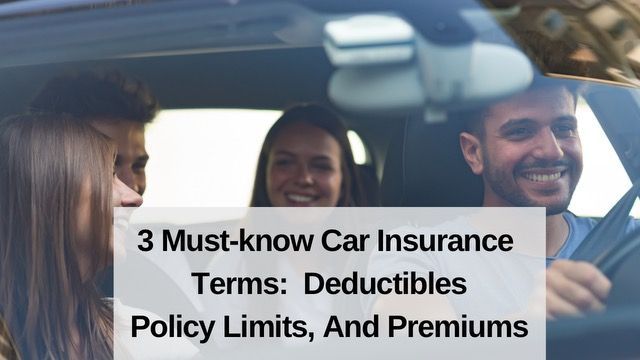3 Must-know Car Insurance Terms: Deductibles, Policy Limits, And Premiums | Blog | Vargas & Vargas Insurance

Let’s Dive into the World of Insurance Premiums, Deductibles, and Policy Limits: Everything You Need to Know!
What Exactly is an Insurance Premium?
Your insurance premium, often referred to as your ‘rate,’ is the regular payment you make for your insurance policy. The frequency of these payments can be monthly, quarterly, semi-annually, or annually, depending on your chosen billing option.
When you browse for insurance online and review quotes, you’re essentially exploring the various payment amounts associated with your premium.
Several factors influence your insurance premium, including:
- Policy Limits: The coverage limits you select for your policy play a significant role in determining your premium.
- Deductibles: The deductible you choose also affects your premium. Higher deductibles typically result in lower premiums, while lower deductibles lead to higher premiums.
- Insurance Claim History: Your past insurance claim history can influence your premium. Fewer previous claims may lead to lower premiums.
Additionally, depending on the type of policy and your state of residence, there may be other components that contribute to your insurance premium.
What Caused the Adjustment in My Insurance Premium?
Several factors can have an influence on your insurance premium, leading to changes over time. One such factor is inflation, which can significantly impact the cost of repairing or replacing your home or vehicle. As the overall cost of goods and services increases due to inflation, the expenses associated with property repairs and replacements also rise. This, in turn, can result in adjustments to your insurance premium to ensure that your coverage adequately accounts for the increased costs associated with potential claims.
Some of the key factors that can lead to changes in your premium include:
- Inflation: As mentioned earlier, inflation can drive up the costs associated with property repairs and replacements.
- Insurance Claim History: Your past claims history can impact your premium. Frequent claims may lead to higher premiums.
- Adding Coverages: Expanding your coverage to include additional protections can result in an increase in your premium.
- Increasing Policy Limits: When you raise the limits of your policy, it can lead to a higher premium.
- Adding Family Members: Including new drivers or family members on your policy can affect your premium.
- Changes to Property or Vehicle: Alterations, renovations, or modifications to your home or vehicle can lead to premium adjustments.
- Change in Usage: If you start using your property or vehicle differently, such as renting a room in your home or changing your vehicle’s primary use, it can influence your premium.
- Driving Record: Your driving history, including accidents and traffic violations, can impact your auto insurance premium.
Insurance premium changes can be quite noticeable because many of us only review our premiums when we receive our bills for the next policy term. To illustrate this, consider the analogy of purchasing all the milk you need for a year. The following year, when you buy all your milk again, you’re likely to notice a significant difference in price due to inflation, as you’re making one large lump-sum purchase.
What Does the Term ‘Insurance Deductible’ Mean?
Your insurance deductible is the amount you contribute toward a covered claim. Let’s say your car sustains damage in an accident, with a total repair cost of $1,200. If your policy has a $500 deductible, you’re responsible for paying $500 towards the repair, while your insurance covers the remaining $700.
This deductible amount is predetermined when you purchase your policy. Even if the repair cost were $2,000, your obligation would still be the fixed $500 deductible, provided it falls within your policy limits (more on that later).
Here’s the key connection:
Opting for a lower deductible typically results in a higher premium, as you’re paying less out of pocket for covered claims. Conversely, choosing a higher deductible often leads to a lower premium because you’re shouldering more of the cost for such claims.
What Is the Amount of My Insurance Deductible?
Your deductible is not a fixed, one-size-fits-all amount. Instead, it depends on the terms of your insurance policy and your choices. To discover your current deductible, refer to your policy documents, typically located on the Declarations page near the front.
Be aware that some policies may have separate deductibles for specific types of losses, like a special wind/hail deductible. If you’re an Auto-Owners policyholder, you can locate your deductible amount in the policy Declarations section.
If you’re still unsure about your deductible amount, your best course of action is to contact your insurance broker.
What Do Insurance Policy Limits Mean?
Your insurance policy’s limit is the maximum amount your insurance provider will pay for a covered loss. If the costs associated with your claim exceed this limit, you may have to cover the remaining expenses out of your pocket. This is why having an independent insurance agent by your side is crucial. They can assist you in determining and setting appropriate coverage limits to ensure you’re not left underinsured.
Being underinsured means having insurance coverage, but the policy limits are insufficient to cover the full extent of your claim. For most personal insurance policies, you’ll need to choose separate limits for your property (such as your car or home) and your liability.
Many insurance policies also offer additional coverages that you can add to help protect you in case your expenses exceed your policy’s limits.
Your Local Independent Insurance Broker
As an independent insurance broker, we work for you, and, we work with top insurance companies across the nation. Our mission is to simplify your insurance shopping experience by securing multiple quotes on your behalf. We specialize in comparing rates, insurance providers, and a wide range of coverage options, making the process straightforward. Should you have any inquiries, our local team is just a phone call away at 617-298-0655, ready to assist you. And here’s the great news: our services come at no cost to you! Plus, you have the convenience of purchasing your preferred insurance policy directly through us.


